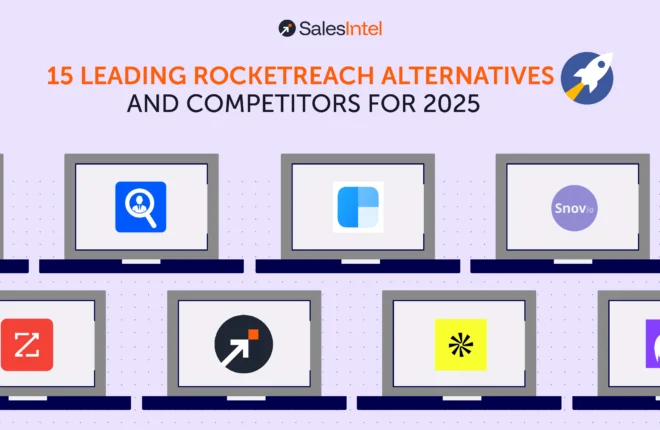B2B data-driven marketing is revolutionizing how businesses interact with their customers, make strategic decisions, and drive growth. By leveraging data insights, B2B marketers can craft more targeted, effective campaigns, predict future trends, and ultimately enhance their ROI. This guide will explore what B2B data-driven marketing is, its advantages, limitations, and best practices to ensure you get the most out of your data-driven efforts.
What Is B2B Data-Driven Marketing?
B2B data-driven marketing refers to the strategic use of data to guide marketing decisions and actions aimed at business-to-business (B2B) clients. It involves leveraging vast amounts of data—ranging from customer demographics and behavior to market trends and competitive analysis—to craft targeted marketing strategies that are more likely to resonate with potential business customers. The goal is to optimize marketing efforts, enhance customer targeting, personalize communication, and ultimately drive better business outcomes.
In essence, data-driven marketing moves away from intuition-based decision-making and instead relies on empirical evidence and data insights. This approach enables marketers to understand their audience at a granular level, predict customer behavior, and tailor marketing strategies that align with customer needs and preferences.
Key Elements Involved in B2B Data-Driven Marketing
- Data Collection
This is the foundation of data-driven marketing. Marketers gather data from various sources, including CRM systems, website analytics, social media, email campaigns, third-party data providers, and more. This data can include information on customer demographics, purchasing behaviors, engagement metrics, and market conditions.
- Data Analysis
Once collected, the data is analyzed to uncover trends, patterns, and insights. Techniques like segmentation, predictive analytics, and machine learning are often used to make sense of large data sets. Analysis helps marketers identify key customer segments, forecast future behavior, and determine the most effective marketing strategies.
- Data Application
The insights derived from data analysis are then applied to marketing campaigns. This can involve personalizing email content, targeting specific customer segments with tailored ads, optimizing marketing spend, and improving customer experiences. Application also includes ongoing performance tracking and campaign optimization to ensure that marketing efforts are effective and efficient.
How It Differs from Traditional Marketing Methods
- Data-Driven vs. Intuition-Based
Traditional marketing often relies on intuition, experience, and general market knowledge. In contrast, data-driven marketing is anchored in objective data and empirical evidence, leading to more precise and impactful marketing decisions.
- Personalization and Targeting
Traditional marketing may use broad, one-size-fits-all approaches, while data-driven marketing focuses on highly personalized and targeted strategies. For example, rather than sending a generic email blast, data-driven marketers can send personalized messages to specific segments based on past interactions or predicted needs.
- Real-Time Adaptability
Data-driven marketing allows for real-time tracking and adjustments. Marketers can quickly identify what’s working and what’s not, and pivot their strategies accordingly. Traditional methods, on the other hand, often rely on longer feedback loops and slower adaptation.
- Measurement and ROI Focus
In data-driven marketing, success is measured through clear metrics and KPIs, allowing for precise calculation of return on investment (ROI). Traditional marketing might struggle with demonstrating direct ROI, as it often relies on less quantifiable results.
- Advanced Technology Utilization
Data-driven marketing leverages advanced technologies such as artificial intelligence (AI), machine learning, and predictive analytics to automate and enhance marketing efforts. These tools provide deeper insights and greater efficiency compared to the manual processes often used in traditional marketing.
B2B data-driven marketing represents a more sophisticated and effective approach to reaching business clients, offering marketers the ability to make informed decisions, personalize their outreach, and ultimately drive superior outcomes compared to traditional methods.
Advantages of B2B Data-Driven Marketing
- Improved Customer Targeting and Personalization
Data-driven marketing allows businesses to segment their audience based on various criteria, such as industry, company size, location, and behavior. This segmentation enables more precise targeting, ensuring that marketing messages are relevant and resonate with the intended audience.
By leveraging data insights, marketers can create personalized content and campaigns that speak directly to the needs and pain points of specific audience segments. This personalization improves engagement rates and increases the likelihood of conversions, as prospects feel understood and valued.
- Enhanced Decision-Making
With access to a wealth of data, B2B marketers can make more informed decisions about their strategies and campaigns. Data analysis provides insights into what’s working and what’s not, allowing businesses to refine their approaches and focus on high-impact tactics.
Data insights help marketers identify market trends, customer behaviors, and competitive dynamics, enabling more strategic decision-making. This empowers businesses to allocate resources effectively, anticipate market shifts, and capitalize on new opportunities.
- Optimized Marketing Spend and ROI
Data-driven marketing allows businesses to track the performance of their campaigns in real-time. By analyzing metrics such as conversion rates, cost-per-lead, and customer acquisition costs, marketers can optimize their marketing spend and ensure a better return on investment.
Data insights help identify underperforming channels or tactics, enabling businesses to reallocate budget towards more effective strategies. This continuous optimization helps maximize marketing efficiency and ensures that resources are used wisely.
- Better Customer Insights and Engagement
By analyzing customer data, businesses gain a deeper understanding of their audience’s preferences, behaviors, and pain points. This insight allows marketers to create more relevant content, offers, and experiences that drive engagement and loyalty.
Data-driven insights enable businesses to connect with customers at the right time, on the right platform, and with the right message. This targeted approach increases the effectiveness of marketing efforts and fosters stronger customer relationships.
- Increased Agility and Adaptability
Data-driven marketing equips businesses with real-time insights, allowing them to respond quickly to market changes, customer needs, or competitive pressures. This agility enables marketers to pivot strategies as needed, keeping campaigns relevant and effective.
With access to up-to-date data, businesses can rapidly test new ideas, measure their impact, and adjust strategies accordingly. This flexibility is crucial in today’s fast-paced business environment, where staying ahead of trends can be a key competitive advantage.
Limitations of B2B Data-Driven Marketing
Data Quality and Integration Issues
- Challenges with Data Accuracy: One of the major limitations of data-driven marketing is the reliance on accurate and complete data. Poor data quality—such as outdated, duplicated, or incomplete information—can lead to incorrect insights and misguided strategies, ultimately harming marketing efforts.
- Integration Difficulties: Integrating data from various sources (e.g., CRM systems, social media, third-party platforms) can be complex and time-consuming. Disparate data sources often have different formats and standards, making it challenging to create a unified view of the customer.
Privacy and Compliance Concerns
- Data Privacy Regulations: With increasing data privacy regulations like GDPR and CCPA, businesses must navigate complex legal requirements to ensure compliance. Collecting, storing, and using data in ways that respect customer privacy is crucial, but can also limit the scope of data-driven initiatives.
- Impact on Marketing Efforts: Privacy concerns can restrict the types of data that businesses are allowed to collect and use. This can limit the depth of insights available for targeting and personalization, and also require additional resources to manage compliance.
High Costs and Resource Requirements
- Financial Investment: Implementing data-driven marketing requires significant financial investment in technology, tools, and data acquisition. Small to mid-sized businesses may find these costs prohibitive, limiting their ability to compete with larger players who have more resources.
- Resource Intensive: Beyond financial costs, data-driven marketing requires skilled personnel, time, and effort to collect, analyze, and interpret data. The need for ongoing maintenance and updates adds to the resource burden.
Analysis Paralysis
- Excessive Data Challenges: While access to vast amounts of data is beneficial, it can also lead to analysis paralysis, where marketers become overwhelmed by the volume of information available. Sifting through large datasets to find actionable insights can be daunting, and over-analysis can delay decision-making.
- Focus on Key Metrics: To overcome analysis paralysis, businesses must focus on the most relevant metrics and avoid getting bogged down by unnecessary data points. Prioritizing key performance indicators (KPIs) can help keep efforts aligned with business goals.
Technical Complexity and Skill Gaps
- Need for Technical Skills: Effective data-driven marketing requires expertise in data analysis, interpretation, and the use of specialized tools and platforms. A lack of technical skills within the marketing team can hinder the ability to fully leverage data insights.
- Skill Gaps: Bridging the gap between traditional marketing skills and data-centric approaches can be challenging. Businesses may need to invest in training or hire new talent with the necessary skills, which can be both costly and time-consuming.
Understanding both the advantages and limitations of B2B data-driven marketing helps businesses to harness its potential while being mindful of the challenges that need to be addressed. By strategically navigating these aspects, companies can optimize their marketing efforts, drive better results, and maintain a competitive edge in the marketplace.
Best Practices for B2B Data-Driven Marketing
Invest in Data Quality and Management
- Importance of High-Quality Data: High-quality data is the foundation of effective data-driven marketing. Investing in data quality involves regularly cleansing, updating, and validating data to ensure accuracy and completeness. This practice minimizes errors, reduces the risk of misguided decisions, and enhances the reliability of insights.
- Data Management Systems: Implementing robust data management systems helps in organizing and maintaining data efficiently. Tools such as CRM platforms and data warehouses can centralize information, making it easier to manage and utilize data across various marketing functions.
Prioritize Privacy and Compliance
- Adherence to Privacy Laws: With stringent data privacy regulations like GDPR, CCPA, and others, businesses must prioritize compliance to avoid legal repercussions and maintain customer trust. This involves implementing proper consent mechanisms, data encryption, and secure data handling practices.
- Building Trust with Transparency: Being transparent with customers about how their data is collected and used not only ensures compliance but also builds trust. Clear privacy policies and easy opt-out options can enhance the customer experience and foster long-term loyalty.
Leverage Advanced Analytics and AI
- Deeper Insights with Advanced Tools: Using advanced analytics and AI-powered tools enables businesses to extract deeper insights from data. Predictive analytics, machine learning algorithms, and AI-driven automation can help identify trends, forecast outcomes, and personalize customer interactions at scale.
- Automation for Efficiency: AI can automate repetitive tasks, such as lead scoring, segmentation, and content recommendations, freeing up resources and allowing marketers to focus on strategy and creativity. This increases operational efficiency and helps achieve better results with fewer manual efforts.
Create a Culture of Continuous Testing and Optimization
- Test-and-Learn Approach: A test-and-learn approach encourages constant experimentation with marketing strategies. By testing different variables—such as messaging, channels, and targeting parameters—businesses can identify what works best and continuously refine their approach.
- A/B Testing and Iteration: Regular A/B testing of campaigns allows marketers to make data-driven decisions based on actual performance results. Iterative improvements based on testing insights help optimize campaigns and enhance overall marketing effectiveness.
Focus on Omnichannel Integration
- Consistent Customer Experiences: Omnichannel integration ensures that customers have a seamless and consistent experience across all touchpoints, whether online or offline. By integrating data from various channels—such as email, social media, websites, and direct sales—marketers can create cohesive and personalized customer journeys.
- Unified View of the Customer: A unified view of the customer enables marketers to better understand their audience’s behaviors and preferences across different channels. This comprehensive perspective allows for more targeted and relevant interactions, increasing engagement and satisfaction.
Map the Customer Journey
- Optimizing Through Data Insights: Mapping the customer journey involves identifying the key stages a customer goes through, from awareness to purchase and beyond. By analyzing data at each stage, businesses can optimize touchpoints to guide prospects smoothly through the funnel.
- Addressing Pain Points: Understanding where prospects drop off or face challenges allows marketers to address pain points and improve the overall customer experience. Data-driven insights can help refine the journey and reduce friction, ultimately driving better conversion rates.
Develop Strong Collaboration Between Teams
- Unified Marketing Approach: Data-driven marketing requires collaboration across different departments, such as sales, customer service, and IT. A unified approach ensures that everyone is aligned with the same goals and has access to the necessary data to perform their roles effectively.
- Cross-Functional Teams: Creating cross-functional teams that include members from various departments fosters better communication and collaboration. This approach helps in breaking down silos and ensures that marketing strategies are integrated and comprehensive.
Monitor Performance and Adjust Strategies
- Regular Performance Assessment: Continuous monitoring of key performance indicators (KPIs) is essential for understanding the effectiveness of marketing strategies. Regular assessments help identify areas of improvement and enable quick adjustments to optimize outcomes.
- Refining Strategies: Based on performance data, marketers can refine their strategies to focus on the most successful tactics. This agile approach allows businesses to stay responsive to market changes and maintain the effectiveness of their campaigns over time.
By following these best practices, B2B marketers can effectively leverage data to drive impactful marketing strategies. Prioritizing data quality, privacy, and compliance, while embracing advanced technologies and fostering collaboration, helps businesses maximize the benefits of data-driven marketing while navigating its complexities.
Turning Data into Decisions: Your Path Forward
The power of data-driven strategies cannot be overstated. By embracing the best practices—such as investing in data quality, prioritizing privacy, leveraging advanced analytics, and fostering collaboration—businesses can unlock new levels of customer understanding, optimize their marketing efforts, and drive better ROI.
However, it’s essential to navigate the challenges of data-driven marketing with a strategic approach. High-quality, human-verified data sources, like SalesIntel, can provide a reliable foundation to build upon, ensuring accuracy and compliance in your marketing endeavors.
Looking ahead, the future of B2B data-driven marketing is bright, with advancements in AI and analytics paving the way for even more sophisticated insights and personalized experiences. As you embark on or continue your data-driven journey, remember that the key is not just in collecting data, but in turning that data into actionable decisions that propel your business forward. Embrace the opportunities, be mindful of the pitfalls, and let data guide you to success.




